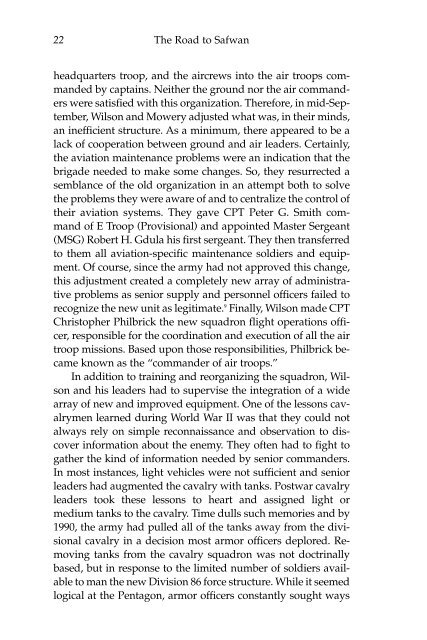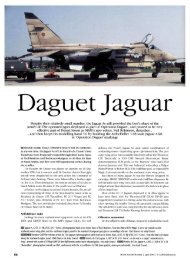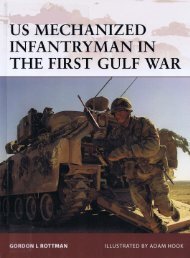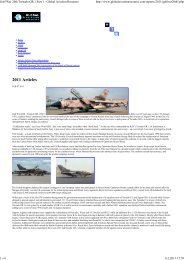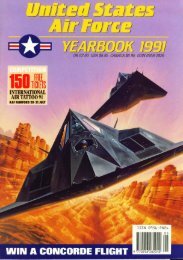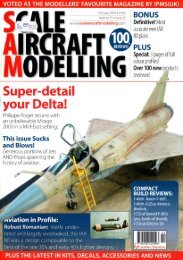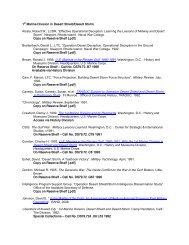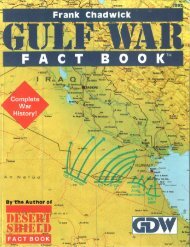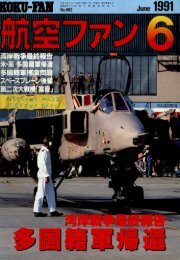The Road to Safwan: The 1st Squadron, 4th Cavalry in the 1991 ...
The Road to Safwan: The 1st Squadron, 4th Cavalry in the 1991 ...
The Road to Safwan: The 1st Squadron, 4th Cavalry in the 1991 ...
You also want an ePaper? Increase the reach of your titles
YUMPU automatically turns print PDFs into web optimized ePapers that Google loves.
22 <strong>The</strong> <strong>Road</strong> <strong>to</strong> <strong>Safwan</strong><br />
headquarters troop, and <strong>the</strong> aircrews <strong>in</strong><strong>to</strong> <strong>the</strong> air troops commanded<br />
by capta<strong>in</strong>s. Nei<strong>the</strong>r <strong>the</strong> ground nor <strong>the</strong> air commanders<br />
were satisfied with this organization. <strong>The</strong>refore, <strong>in</strong> mid-September,<br />
Wilson and Mowery adjusted what was, <strong>in</strong> <strong>the</strong>ir m<strong>in</strong>ds,<br />
an <strong>in</strong>efficient structure. As a m<strong>in</strong>imum, <strong>the</strong>re appeared <strong>to</strong> be a<br />
lack of cooperation between ground and air leaders. Certa<strong>in</strong>ly,<br />
<strong>the</strong> aviation ma<strong>in</strong>tenance problems were an <strong>in</strong>dication that <strong>the</strong><br />
brigade needed <strong>to</strong> make some changes. So, <strong>the</strong>y resurrected a<br />
semblance of <strong>the</strong> old organization <strong>in</strong> an attempt both <strong>to</strong> solve<br />
<strong>the</strong> problems <strong>the</strong>y were aware of and <strong>to</strong> centralize <strong>the</strong> control of<br />
<strong>the</strong>ir aviation systems. <strong>The</strong>y gave CPT Peter G. Smith command<br />
of E Troop (Provisional) and appo<strong>in</strong>ted Master Sergeant<br />
(MSG) Robert H. Gdula his first sergeant. <strong>The</strong>y <strong>the</strong>n transferred<br />
<strong>to</strong> <strong>the</strong>m all aviation-specific ma<strong>in</strong>tenance soldiers and equipment.<br />
Of course, s<strong>in</strong>ce <strong>the</strong> army had not approved this change,<br />
this adjustment created a completely new array of adm<strong>in</strong>istrative<br />
problems as senior supply and personnel officers failed <strong>to</strong><br />
recognize <strong>the</strong> new unit as legitimate. 9 F<strong>in</strong>ally, Wilson made CPT<br />
Chris<strong>to</strong>pher Philbrick <strong>the</strong> new squadron flight operations officer,<br />
responsible for <strong>the</strong> coord<strong>in</strong>ation and execution of all <strong>the</strong> air<br />
troop missions. Based upon those responsibilities, Philbrick became<br />
known as <strong>the</strong> “commander of air troops.”<br />
In addition <strong>to</strong> tra<strong>in</strong><strong>in</strong>g and reorganiz<strong>in</strong>g <strong>the</strong> squadron, Wilson<br />
and his leaders had <strong>to</strong> supervise <strong>the</strong> <strong>in</strong>tegration of a wide<br />
array of new and improved equipment. One of <strong>the</strong> lessons cavalrymen<br />
learned dur<strong>in</strong>g World War II was that <strong>the</strong>y could not<br />
always rely on simple reconnaissance and observation <strong>to</strong> discover<br />
<strong>in</strong>formation about <strong>the</strong> enemy. <strong>The</strong>y often had <strong>to</strong> fight <strong>to</strong><br />
ga<strong>the</strong>r <strong>the</strong> k<strong>in</strong>d of <strong>in</strong>formation needed by senior commanders.<br />
In most <strong>in</strong>stances, light vehicles were not sufficient and senior<br />
leaders had augmented <strong>the</strong> cavalry with tanks. Postwar cavalry<br />
leaders <strong>to</strong>ok <strong>the</strong>se lessons <strong>to</strong> heart and assigned light or<br />
medium tanks <strong>to</strong> <strong>the</strong> cavalry. Time dulls such memories and by<br />
1990, <strong>the</strong> army had pulled all of <strong>the</strong> tanks away from <strong>the</strong> divisional<br />
cavalry <strong>in</strong> a decision most armor officers deplored. Remov<strong>in</strong>g<br />
tanks from <strong>the</strong> cavalry squadron was not doctr<strong>in</strong>ally<br />
based, but <strong>in</strong> response <strong>to</strong> <strong>the</strong> limited number of soldiers available<br />
<strong>to</strong> man <strong>the</strong> new Division 86 force structure. While it seemed<br />
logical at <strong>the</strong> Pentagon, armor officers constantly sought ways


